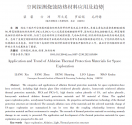You are using an out of date browser. It may not display this or other websites correctly.
You should upgrade or use an alternative browser.
You should upgrade or use an alternative browser.
China's Space Program Thread II
- Thread starter Blitzo
- Start date
by78
General
A announcing the successful completion of tests of a liquid metal thermal management system. The tests were carried out onboard the Chinese space stateion.


Recently, the China Academy of Space Technology completed China's first liquid metal thermal management in-orbit test in the field of space technology in the space technology test field, and achieved a series of key technical achievements. At present, various pilot projects in the field of space technology testing are being carried out as planned.
The heat conduction and heat absorption capacity of liquid metals is much greater than that of traditional heat conductive agents, which can achieve rapid emission of high heat, and has high application value in aerospace, advanced energy, high-power devices and other fields. Liquid metal thermal management technology mainly includes interface heat conduction, convection heat transfer and phase change temperature control technology, which is one of the key technologies of space high heat flow density heat dissipation system.
Based on the advantages of simple structure, strong heat transfer ability, high temperature control uniformity, low vibration and low noise of the heat dissipation system based on liquid metal, it can efficiently and reliably realize the heat transfer between high-temperature heat sources such as reactors or isotopes and thermoelectric conversion devices, and can provide high-performance heat for high-power electronic devices or high-power equipment. The impact response ability has broad application prospects in future space missions such as starmeter nuclear power plants, deep space detector nuclear power supplies, and super-power load heat dissipation systems.
The field of aerospace technology testing is facing the future development of spacecraft energy system and industrial application needs. After extensive research and in-depth demonstration, a key technology test and verification project of liquid metal space thermal management in orbit has been put forward.
The liquid metal thermal management test device in the field of aerospace technology test was developed by the Institute of Physical and Chemical Technology of the Chinese Academy of Sciences and installed in the aerospace basic test cabinet of the Mengtian experimental module of the space station. It adopts bismuth-based metal with low melting point, high biosafety and stable chemical characteristics to carry out flow heat dissipation and phase change control in the space microgravity environment. Research and test verification of temperature technology.
After the device is put into orbit, the on-orbit test and two-stage on-orbit test have been completed successively. The device runs stably throughout the whole process, verifies key technologies such as bismuth-based metal controlled melting, expansion buffering, convection heat transfer and phase change temperature control in the space microgravity environment, and obtains the pure forced convection heat transfer characteristic data of the liquid metal laminar flow-turbulent transition zone and the characteristic data of phase change temperature control capacity in the microgravity environment, which is space liquid gold. The design of a high heat flow density heat dissipation system provides a key technical basis.
by78
General
Beautiful HD footage of the latest spacewalk. Thumbs-up to the background music (Prokofiev).
Correction: The background music is by Maurice Ravel.
Could you kindly link the original article source for this picture? I want to marslocate it, it looks like a polar cap boundary.Newly released images of Mars taken by the medium-resolution camera of the Tianwen-1 orbiter.

Tianzhou-6 cargo spacecraft living broadcast.
Tianzhou-6 cargo spacecraft living broadcast.
Also in English at CTGN.
Liftoff at 8:30

An interesting read of ablator heat retadation material. My intention of putting it here is not about technology itself, but rather how wrong or irrelevant people frequently ask the questoin "how many years China is behind US in technology area." My answer was always "anywhere from x number of years behind to y number of years ahead". Usually people will use the known date of operation as the bench mark. By examing the history using the dates presented by this document I am proving that the "usual way of thinking" is pointless. This post not only applies to this thread but to all subjects everywhere.
Here is the comparison by first date of operation.
- Avcoat5026-39HC/G from US was used for Apollo and Orion today. It is used since 1961. It's density was 0.55g/cm3 or is 0.51g/cm3 (Orion) depending on the source quoated.
- Shenzhou's equivlant was 0.71g/cm3. It is used since 1999. Using the "usual" comparison, China was MORE than 38 years behind US.
- Chang'e-5's tile was 0.5g/cm3. It is slightly betther than Avcoat. It was lauched in 2014 (T1). The "usual" would give 53 years behind.
- Tianwen-1's tile is 0.4g/cm3 in 2021. By 2021 China was ahead of US if taking the "usual" way.
Now comes the funny part, if someone asked the question between 2014 and 2021, what would the answer be? 53 (2014) or 60 (2021) years behind according to the "usual" way of thinking? Or many years ahead in reality?
If one ask the question today in 2023, the answer must be that US is indefinitly behind China utill US got something below 0.4g/cm3 based on the "usual" way of thinking.
BTW, the latest figure from China is 0.3g/cm3 in 2016, although no known spacecraft is reported to use it, but it is highly likely that it has been used by the next generation manned capsule which was launched in 2020 considering 0.4g/cm3' quick application on Tianwen-1. So now the bench mark is 0.3g/cm3 for US to catch.
By now, it is clear how rediculous the question of "how many years behind/ahead" and the "usual" answer are. The proper answer should be "can be anything, nobody knows".
Last edited:











